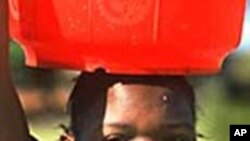A new study by the London-based International Institute for Environment and Development (IIED) says over half of all urban dwellers in Malawi do not have adequate access to water. The problem is severe in the townships, which are home to about 60 percent of the urban population, according to the study.
The research, which was sponsored by the Scottish government, shows that only a quarter of the households in the nine urban settlements surveyed had individual water connections.
Half relied on water bought from water kiosks, some which are open for only a few hours a day. Thirteen percent of households bought water from neighbors who have running water. The rest take it from unsafe sources, including polluted wells.
"I often go to work late because I can not access water from the nearby tap. It is often dry. Instead I collect water every morning from a dug well half kilometer away,” says Timothy Mkandawire a resident of Katoto in the northern city of Mzuzu.
The erratic water supply is forcing urban residents to fall back on unsafe water sources, he says, with some drawing water from swamps.
It is not unusual to see women and girls in rural areas balancing on their heads buckets of water from rivers, communal wells and boreholes far from home.
However, the practice now stretches to the country's main cities of Lilongwe, Blantyre and Mzuzu.
“I don’t see the difference between living in town and rural areas these days. Here in town we also struggle fetching water since taps run dry frequently," says Beatrice Sumani a resident of Mbayani Township in the Blantyre.
"We walk long distances searching for safe water. Sometimes we resort to fetching water from unsafe sources like rivers and open wells. We use them without any disinfectants, like chorine."
Many women, who are traditionally responsible for collecting water, she says, tend to be late for work, if they have jobs, because they have to spend early morning scouting for water to drink, wash and cook.
The study’s findings contradict statistics published by the government of Malawi, which show that nearly all urban citizens have access to safe water and sanitation. They also draw into question the government’s efforts to meet the UN’s Millennium Development Goals, or MDGs. They call for a dramatic improvement in access to clean water and sanitation in the developing world.
The government's 2007 Malawi MDG report says access to water in urban areas has improved significantly, from 47 percent in 1992 to 75 percent today.
The country’s principal secretary for water development, Andrina Mchiela, says Malawi is working tirelessly to achieve the MDGs by 2015. She has told local media the government is working to ensure that 80 percent of Malawians to have access to clean water and improved sanitation by 2013.
President Bingu wa Mutharika told a press conference in Lilongwe he is optimistic that come 2015, his government will probably implement some, if not all, of the MDGs objectives, including those that call for access to clean water.
“We are lucky in Malawi because we made sure [the priorities we’ve devised] coincide with MDGs so that when we are implementing our priorities we also implement the MDGs. That’s why I am comfortable. Come 2015 we will make it,” says Mutharika.









